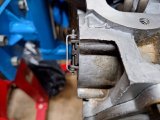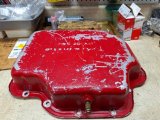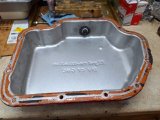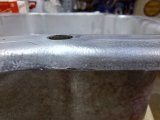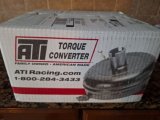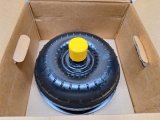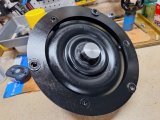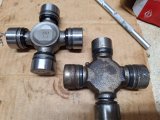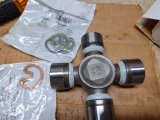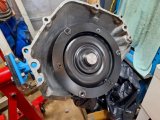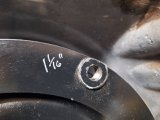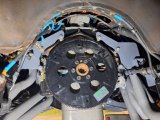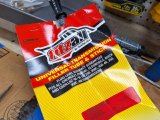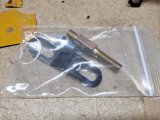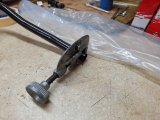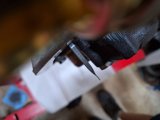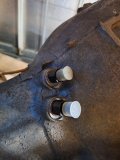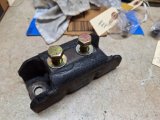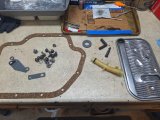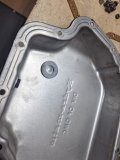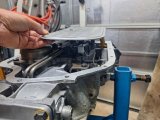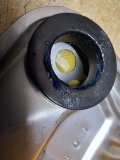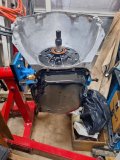Valve Body Part 2 .....
I installed 5 of the 6 checkballs, using online and ATSG as locating verification.
#1 checkball is omitted when the direct drum dual feed mod has been done - it's the one outlined in color.
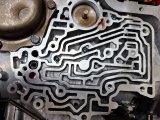
Governor tube screen installed into the case in the hole closest to the center of the unit.
Cone faces up into the governor tube.
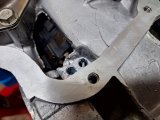
2-3 accumulator piston installed. Spring, then retainer.

Followed by shaft, retaining clip and piston. Note that retaining clip goes into the bore before piston.
Piston with new teflon seal was eased into the bore, flat side up.
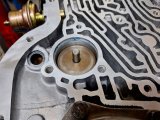
Getting the VB aligned with governor tubes, gaskets, and shift pin was fiddly enough that I made a couple of alignment pins (recommended in the ATSG manual) to help keep everything lined up. This was very helpful.
Note that the downshift solenoid is loosely installed at this point.
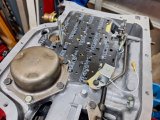
Valve body installed over the alignment pins. You're adjusting the VB and governor tubes at the same time as you do this.
The VB won't sit flush due to the 2-3 accumulator spring - as you tighten the VB bolts you can push it down slightly to ensure full alignment.
You want to wiggle everything slightly to be sure that all bolts insert easily through the gaskets/separator plate.
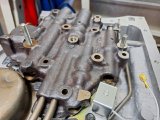
Verify that the shift pawl pin is correctly engaged into the manual valve, and that the retaining bolt has the spring clip.
The valve should move freely throughout the shift range.

Valve body installed and torqued to 98 in/lb.
I typically use a torque wrench on every critical installation with paint mark on the bolt head to indicate "done".
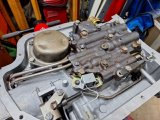
Detent (downshift) solenoid bolts torqued to 89 in/lbs and wire connected to the new case connector.
That's a new detent solenoid too. Note - pay attention to the wire routing, keep it away from the shift rod movement.
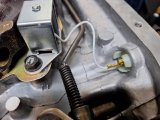
New dipstick tube seal installed.
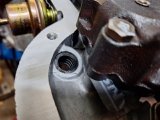
I installed 5 of the 6 checkballs, using online and ATSG as locating verification.
#1 checkball is omitted when the direct drum dual feed mod has been done - it's the one outlined in color.

Governor tube screen installed into the case in the hole closest to the center of the unit.
Cone faces up into the governor tube.

2-3 accumulator piston installed. Spring, then retainer.

Followed by shaft, retaining clip and piston. Note that retaining clip goes into the bore before piston.
Piston with new teflon seal was eased into the bore, flat side up.

Getting the VB aligned with governor tubes, gaskets, and shift pin was fiddly enough that I made a couple of alignment pins (recommended in the ATSG manual) to help keep everything lined up. This was very helpful.
Note that the downshift solenoid is loosely installed at this point.

Valve body installed over the alignment pins. You're adjusting the VB and governor tubes at the same time as you do this.
The VB won't sit flush due to the 2-3 accumulator spring - as you tighten the VB bolts you can push it down slightly to ensure full alignment.
You want to wiggle everything slightly to be sure that all bolts insert easily through the gaskets/separator plate.

Verify that the shift pawl pin is correctly engaged into the manual valve, and that the retaining bolt has the spring clip.
The valve should move freely throughout the shift range.

Valve body installed and torqued to 98 in/lb.
I typically use a torque wrench on every critical installation with paint mark on the bolt head to indicate "done".

Detent (downshift) solenoid bolts torqued to 89 in/lbs and wire connected to the new case connector.
That's a new detent solenoid too. Note - pay attention to the wire routing, keep it away from the shift rod movement.

New dipstick tube seal installed.

Last edited:


